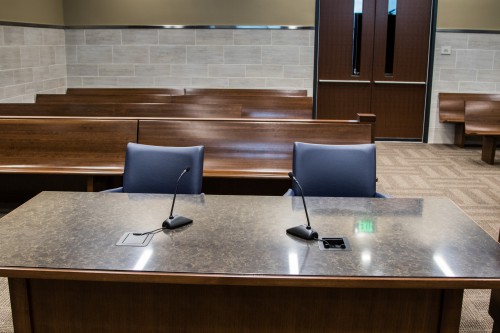
Jury Reaches a Verdict on Gang-Related Robbery
By Kelsey Landon
On Thursday afternoon November 9, 2017, the trial for Joshua Armond Cadenaz-Lopez and co-defendant Ricky Gomez Hernandez ended with the jury reaching a verdict on all counts the two men were facing.
The jury found both Cadenaz-Lopez and Hernandez guilty on almost all counts, and found gang-related special findings and enhancements to be true on all counts for which they found the men guilty.
The only charges the jury found the co-defendants not guilty of were Count 1, charging Hernandez with discharging a firearm with malicious intent from a vehicle; Count 18, charging Hernandez with the use of a firearm; and Count 19 against Hernandez, charging him with conspiring to commit a felony.
Both counsels and defendants will appear before Judge David Rosenberg on December 12, 2017, at 8:30 a.m. for a final report and sentencing.
Previous: Prosecution Closing Statements Given in Codefendant Robbery Case
By Fabiha Zaman
On Tuesday morning, the jury trial for codefendants Joshua Armond Cadenaz-Lopez and Ricky Gomez Hernandez moved into closing statements. The defendants have been charged with more than 20 counts including second-degree robbery and additional enhancements related to firearms and gang activity.
Judge David Rosenberg instructed Deputy District Attorney Kyle Hasapes to begin his closing statement after examining qualms from counsel concerning admitted evidence. Mr. Hasapes began with the words “fear, terror, and intimidation” to describe what this case is about and what all the victims were faced with. He added that the defendants have committed such violence for the purpose of gaining respect and improving their reputation.
Mr. Hasapes introduced his argument by saying that his examination of all the evidence will show that the defendants are sophisticated criminals. His findings will help the jury find beyond a reasonable doubt that the defendants are guilty on all counts.
The People began by presenting the testimony from forensic analyst Jonathan Sewell, who tested the DNA found in the gloves used during one of the robberies. The green gloves specifically had four different 
contributors, one major contributor and three minor contributors. Mr. Hasapes reminded the jury that the DNA in the glove matched Cadenaz-Lopez’s DNA profile and that he was identified as the major contributor. The major contributor refers to the person who used the item closer to the time the sample was taken and used it more frequently and more vigorously.
Mr. Hasapes also went through all the items linked to the robberies and the defendants, including but not limited to articles of clothing, bandanas, shoes, and wrappers of Swisher and Zig Zag Sweet products allegedly stolen on Oct. 19, 2016, when most of the robberies occurred. All these other items were found in the cars linked to the defendants, which were later identified by the defendants themselves, or from the search of their apartment.
The four robberies that took place on the night of the 19th were all 20 to 30 minutes apart, and at four different locations that were strategically spaced out. Mr. Hasapes argued that this is indicative of how the robberies were all planned incidents.
The attempted robbery at Nicky’s Market had two primary witnesses, the store owner and his wife. The store owner observed suspicious behavior when Hernandez walked in, so he followed him out of the store. Once Hernandez noticed the store owner following him, he turned around to intimidate him by lifting up his shirt to reveal a silver gun tucked into his waistband. The store owner later identified the silver revolver, found in one of the cars linked to the defendants, as being similar to the type of gun he saw on Hernandez. The store owner’s wife also added in her testimony that she saw two sparks and then heard two gunshots as the defendants ran back to their car.
Mr. Hasapes then directed the jury’s attention to a photo taken from surveillance cameras in Nicky’s Market. The photo showed Hernandez wearing black shoes with white soles and a low ponytail with a single strand of hair falling out of the ponytail. He was also wearing a white tank top and black pants. Hasapes asked the jury to keep these clothing items in mind as he reviewed the other robberies.
The deputy district attorney then proceeded to inspect the four robberies, including the robbery of the ampm convenience store on Florin Road, the robbery at Denny’s, the robbery at 7-Eleven, and lastly the robbery at another ampm convenience store on Orchard Road. With each of these robberies that occurred on the night of Oct. 19, 2016, Mr. Hasapes reviewed characteristics he found similar among all the robberies.
One thing Mr. Hasapes noted was the clothes the defendants wore at each robbery. After replaying the surveillance footage from each robbery to remind the jury, Mr. Hasapes concluded that it was indeed Hernandez and Cadenaz-Lopez in the footage. He pointed out the red bandana and black bandanas on the faces of the defendants. He also showed Cadenaz-Lopez wearing the same green gloves inspected by Mr. Sewell, an unzipped jacket, and black shorts. Hernandez also seemed to be wearing the same outfit he wore during the attempted robbery at Nicky’s Market. He zoomed in on their faces in each of the videos to show the resemblance and connected visible tattoos in the photos to ones the court had seen on the defendant’s bodies from pictures taken the day they were arrested.
The most important things Mr. Hasapes went through with each case were the roles of each of the codefendants and their alleged co-conspirator Nicholas Lopez during the robberies. He highlighted the way they always parked the car farther away from the target. First Cadenaz-Lopez would walk in and go straight to the register and threaten the cashier, then Hernandez would walk in and take the cash out of the register, and Lopez would enter last to secure the area. Mr. Hasapes instructed the jury to pay close attention to these consistencies in the robberies because they supplement Hispanic criminal street gang expert Matthew Boudinot’s testimony when he explained how gangs commit crimes together to better their reputation with other members and create fear in the community, which they see as respect.
After thoroughly reviewing the robberies, Mr. Hasapes attempted to prove the codefendants were also guilty of the possession of marijuana for sale. He used statements made from the codefendants to each other when they were waiting in the interview room at the West Sacramento Police Department. In the footage from the interview, Cadenaz-Lopez told Hernandez something about the marijuana they had in the car when they were arrested. Additionally, Hernandez was later found to have three phones, two of which he used to sell marijuana with sales texts from March 2016 to July 2016.
Codefendants Hernandez and Cadenaz-Lopez are also charged with carrying concealed firearms, a point Mr. Hasapes pursued by again showing the jury the statements that were made in the interview room, where Cadenaz-Lopez told Hernandez that they should have left the firearms stashed elsewhere instead of in the car if they wanted to evade suspicion from officers.
Mr. Hasapes then explained to the jury how they should approach the 23 counts, not including enhancements, and how they should evaluate the defendants. Before he could finish, Judge Rosenberg asked him to wrap up his closing statement as time had run out. Mr. Hasapes ended by asking the jury to find Hernandez and Cadenaz-Lopez guilty on all counts, then Judge Rosenberg dismissed the jury for lunch break.
Closing Arguments in the Gang Robbery Trial
By Hannah Poploskie
The case of Ricky Hernandez and Joshua Cadenaz-Lopez resumed closing arguments on Tuesday afternoon. Both are facing charges of robbery with multiple enhancements including gang affiliation, weapon charges, and drug possession.
Deputy Public Defender Lisa Lance, on behalf of Mr. Hernandez, presented the jury with a PowerPoint presentation in conjunction with her oral statements. She contended that the burden of proof was not met by the prosecution on all charges. It was alleged by her that the government had overcharged Mr. Hernandez.
Reviewing some of the evidence shown in the case, Ms. Lance told the jury that it was up to them to go over the evidence again with a clear mind and without the conjecture of the prosecution. She particularly highlighted some of the conversations in the police witness room between the defendants. Ms. Lance showed transcripts of what was said, and alleged that, based on those words alone, it was impossible to draw the conclusions that the prosecution was trying to depict.
Turning toward physical evidence, Ms. Lance told the jury that a gun which was claimed to have been seen in Mr. Hernandez’s waistband in a video could not be positively identified as such. She offered alternative possibilities for the object and referred to a previous robbery brought up in earlier proceedings, where the suspect had a garden hose spout, which the clerk had feared was a gun, in his waistband .
Ms. Lance continued going through some other evidence in the case. She mentioned a red bandana that was worn for a robbery, but bore no DNA matching to Mr. Hernandez. She told the jury that if he was wearing it to obscure his face, there would be DNA evidence on it.
Regarding the allegations that the Broderick Boys is a criminal street gang, she told the jury that there was no evidence that it was a current gang. She also referenced a rap video that was filmed with lyrics mentioning Mr. Hernandez, telling the court that there was no way he could have been involved with the making of the video or been aware of its contents, as he was in custody.
An altercation, alleged to have happened on F Street, was discussed next. Ms. Lance referenced witness testimony that a flashlight was being waved in the air and was later recovered at the scene. She denied that any weapons were present at the scene and none were found. Ms. Lance told the court that no crime had happened on F Street.
Ms. Lance alleged that there was mishandling of evidence by the police. She pointed to a mix up in police files, misidentifying Mr. Hernandez as another individual, in the records for years before being mentioned. She also described that there was no clear lead detective on the case, which caused confusion.
The question of why certain evidence was withheld from the defense was brought up as well. Ms. Lance told the court that some exhibits were not brought to the attention of the defense until presented in court, which was against practice.
Concluding her closing statements, Ms. Lance told the court that they needed to remember the instructions given to them. She told them to remember burden of proof, offering an anecdote to help clarify its meaning, and to go through each count carefully to make sure that it is met. She told the court to only convict Mr. Hernandez of the crimes which he committed, and not to be swayed by conjecture or innuendo put forth by the prosecution.
Attorney Jem Martin, the representative of Mr. Cadenaz-Lopez, then began his closing arguments. Playing a video of the defendant smoking marijuana, Mr. Martin declared, pertaining to the robbery, this was all that needed to be considered. He told the court that it was more than reasonable to believe that his client was passed out at the time of the robberies. He referenced other videos where Mr. Cadenaz-Lopez was seen taking drugs around the time of the robberies.
Mr. Martin told the jury that the defendant was borrowing his girlfriend’s car while she was out of town. She went out of town because she needed some space from the defendant, and this distance sent the defendant into a drug-using tailspin, such that he later remarked being arrested may have helped him escape from “using.”
When discussing if the Broderick Boys are indeed a gang, Mr. Martin denied that there was any evidence of it. He told the jury that there was no rival gang of the Broderick Boys, and that the crimes committed were small-time crimes. It was alleged that no taxes were paid to the gang, a practice required in criminal street gangs. A witness was referenced who testified that the Broderick Boys was a gang in the 70s but had dissolved after.
Physical features of the defendant were argued, referring to identifying him from the video from the robbery. The position of a chest tattoo was mentioned, it being alleged that in the surveillance footage there was no discoloration seen where the tattoo was. The fact that the defendant had hairy legs was told to the court, pointing again to footage where the perpetrator appeared to have hairless legs.
Throughout his closing testimony, Mr. Martin brought up another individual who was an acquaintance of Mr. Cadenaz-Lopez’s. In one video shown, he had similar clothing to what was worn by the robber in the surveillance footage. He also was identified as being a minor, and hence more likely to have more hairless legs. When showing a photo of the minor’s face, he appeared to be clean-shaven, whereas Mr. Cadenaz-Lopez had facial hair. The robber appeared to have no hair on his face.
Turning to the F Street incident, Mr. Martin pointed to the color difference between the car mirror found at the scene and the one that remained on the car the defendant was in possession of. The validity of the witness testimony was also questioned.
Mr. Martin told the court that, while he could not prove beyond a reasonable doubt that the minor was the true perpetrator, the fact that there were certain elements linking that individual to the crime offered reasonable doubt for his client. Mr. Martin repeated that he did not have to prove that Mr. Cadenaz-Lopez did not do it, but to offer that there was reasonable doubt that he committed the crime.
In his rebuttal argument, Deputy District Attorney Kyle Hasapes offered five cases of Broderick Boys’ crimes that validated gang members. He told the jury that they only needed one case to prove that a gang existed, and he had five.
A rap video that was allegedly filmed by the gang was shown, in which Cadenaz-Lopez was featured, which had lyrics suggesting being a member of a gang. Mr. Hasapes said that being in the video showed respect, and that Mr. Hernandez was mentioned in lyrics showed that he was looked up to by some members of the gang. Mr. Hasapes continued that all that had to be identified was that the defendants were in the company of another gang member when crimes were committed, which he said happened.
Mr. Hasapes closed by telling the court that they needed to look at the evidence provided to find the defendants guilty. The jury was then sent to deliberate.






Thank you for getting these gang members off the street! We appreciate your hard work!
How could you even call them gang members? Do you know them? Maybe the jury was wrong. I mean they don’t know them all they know is what they are getting told. I don’t think it is right to judge someone on what you read.